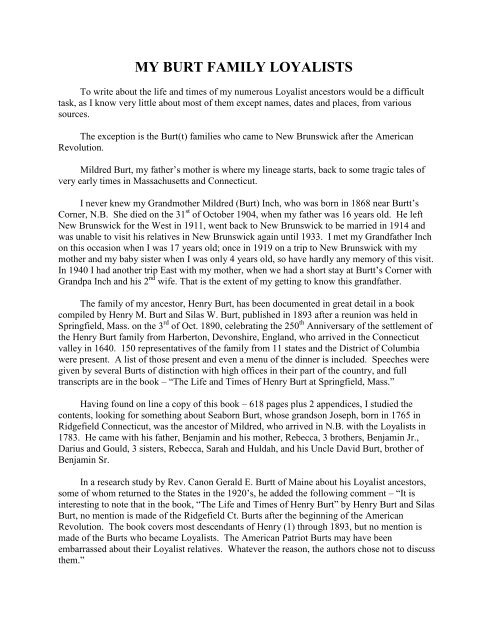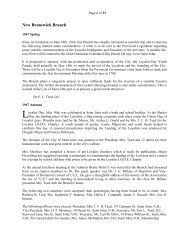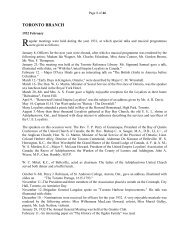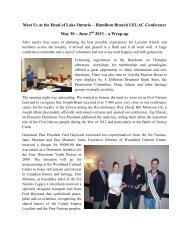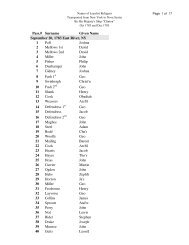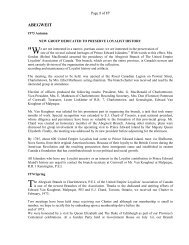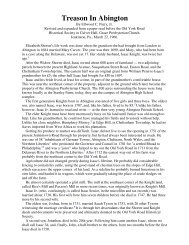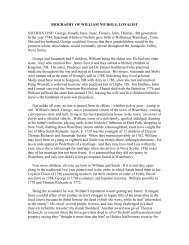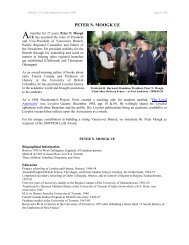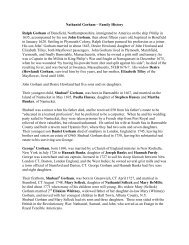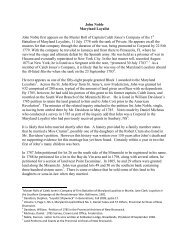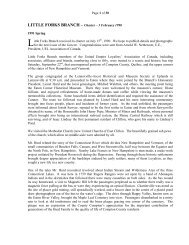MY BURT FAMILY LOYALISTS
MY BURT FAMILY LOYALISTS
MY BURT FAMILY LOYALISTS
Create successful ePaper yourself
Turn your PDF publications into a flip-book with our unique Google optimized e-Paper software.
<strong>MY</strong> <strong>BURT</strong> <strong>FAMILY</strong> <strong>LOYALISTS</strong><br />
To write about the life and times of my numerous Loyalist ancestors would be a difficult<br />
task, as I know very little about most of them except names, dates and places, from various<br />
sources.<br />
The exception is the Burt(t) families who came to New Brunswick after the American<br />
Revolution.<br />
Mildred Burt, my father’s mother is where my lineage starts, back to some tragic tales of<br />
very early times in Massachusetts and Connecticut.<br />
I never knew my Grandmother Mildred (Burt) Inch, who was born in 1868 near Burtt’s<br />
Corner, N.B. She died on the 31 st of October 1904, when my father was 16 years old. He left<br />
New Brunswick for the West in 1911, went back to New Brunswick to be married in 1914 and<br />
was unable to visit his relatives in New Brunswick again until 1933. I met my Grandfather Inch<br />
on this occasion when I was 17 years old; once in 1919 on a trip to New Brunswick with my<br />
mother and my baby sister when I was only 4 years old, so have hardly any memory of this visit.<br />
In 1940 I had another trip East with my mother, when we had a short stay at Burtt’s Corner with<br />
Grandpa Inch and his 2 nd wife. That is the extent of my getting to know this grandfather.<br />
The family of my ancestor, Henry Burt, has been documented in great detail in a book<br />
compiled by Henry M. Burt and Silas W. Burt, published in 1893 after a reunion was held in<br />
Springfield, Mass. on the 3 rd of Oct. 1890, celebrating the 250 th Anniversary of the settlement of<br />
the Henry Burt family from Harberton, Devonshire, England, who arrived in the Connecticut<br />
valley in 1640. 150 representatives of the family from 11 states and the District of Columbia<br />
were present. A list of those present and even a menu of the dinner is included. Speeches were<br />
given by several Burts of distinction with high offices in their part of the country, and full<br />
transcripts are in the book – “The Life and Times of Henry Burt at Springfield, Mass.”<br />
Having found on line a copy of this book – 618 pages plus 2 appendices, I studied the<br />
contents, looking for something about Seaborn Burt, whose grandson Joseph, born in 1765 in<br />
Ridgefield Connecticut, was the ancestor of Mildred, who arrived in N.B. with the Loyalists in<br />
1783. He came with his father, Benjamin and his mother, Rebecca, 3 brothers, Benjamin Jr.,<br />
Darius and Gould, 3 sisters, Rebecca, Sarah and Huldah, and his Uncle David Burt, brother of<br />
Benjamin Sr.<br />
In a research study by Rev. Canon Gerald E. Burtt of Maine about his Loyalist ancestors,<br />
some of whom returned to the States in the 1920’s, he added the following comment – “It is<br />
interesting to note that in the book, “The Life and Times of Henry Burt” by Henry Burt and Silas<br />
Burt, no mention is made of the Ridgefield Ct. Burts after the beginning of the American<br />
Revolution. The book covers most descendants of Henry (1) through 1893, but no mention is<br />
made of the Burts who became Loyalists. The American Patriot Burts may have been<br />
embarrassed about their Loyalist relatives. Whatever the reason, the authors chose not to discuss<br />
them.”
- 2 -<br />
Henry Burt, the immigrant, from Harberton, Devonshire, England, and his wife Eulalia<br />
Marche, had 13 children, the last four born in Springfield, Mass. He had 3 sons, Jonathan, David<br />
and Nathaniel. Christopher (born 1704) and Seaborn (born 1706) were sons of Benjamin, son of<br />
David, and are only mentioned in the context of their birth to Benjamin Burt and Sarah Belden,<br />
whose capture in the Deerfield, Mass. raid by a French and Indian expedition in February 1704 is<br />
a tragic tale of frontier life, I would like to include. This story is summarized from a chapter in<br />
“The Life and Times of Henry Burt”.<br />
Benjamin Burt (1680 – 1759) the great grandfather of Joseph, the Loyalist, had moved<br />
from Northampton, Mass. to Deerfield, an outpost settlement, and on October 19, 1702 he<br />
married Sarah Belden. On Feb. 29 th 1704 an expedition from Montreal, Canada, under Major<br />
Hertel de Rouville, consisting of 200 Frenchmen and 142 Indians made a late night attack on this<br />
town, which was undefended. Many of the inhabitants were slaughtered and their homes<br />
destroyed. Benjamin Burt and his wife were among the 112 prisoners who were forced to the<br />
north of the village and from there started on their journey to Canada, up the valley of the<br />
Connecticut river, through deep snow and rugged wilderness. The conditions and suffering<br />
experienced by these unfortunate people was hard to describe, being poorly clad and shod,<br />
having had no chance to prepare for the journey. They suffered from fatigue and insufficient<br />
food, and when they lagged or were disabled, they were slain by the ruthless savages. Nineteen<br />
captives were slain, mostly pregnant women.<br />
Mrs. Sarah Burt was in the 8 th month of her first pregnancy when they started out. On<br />
March 25 th the party reached Chamble about 18 miles northeast of Montreal. Here, on April 14,<br />
Mrs. Burt gave birth to her first child, a son, named Christopher. A large number of the captives<br />
were employed in a convent and Jesuit Academy near Montreal. Mr. & Mrs. Burt were among<br />
them.<br />
Ensign John Sheldon made 4 expeditions to Canada to rescue his fellow townsmen, and on<br />
May 30 th , 1706 obtained the release of about 40 of them, including Mr. Burt, his wife and child.<br />
They traveled down the St. Lawrence River, then by sea to Boston, arriving on Aug. 2 nd . On the<br />
voyage Mrs. Burt bore her 2 nd child, a son who was named Seaborn, from the place of his birth.<br />
Included in the story was a letter, dated Aug. 22, 1706 written from Boston by a Mr.<br />
Sewell, to the pastor, Rev. John Williams, still in Canada, who had been with the captives and<br />
whose wife was slain by the Indians on the march north. In it he says “……….It was a great<br />
blessing to see Mr. Willard baptize Ebenezer Hinsdale and Seaborn Burt, two little sons born on<br />
the passage. The captives, most of them, began their journey home on the 12 th inst.”<br />
On arriving at Deerfield Mr. Burt and his family were overwhelmed by the memories of<br />
their misfortunes, and the massacre of many near relatives in the border wars. The names of<br />
relatives who lost their lives are listed – 10 on Mr. Burt’s side and 8 on Sarah’s. The horrors<br />
experienced when the town was destroyed caused them to leave Deerfield. They went first to<br />
Stamford, then to Norwalk and finally settled in Ridgefield Ct. where Mr. Burt was given a grant<br />
of land with the condition that he remain as blacksmith for the town.
- 3 -<br />
Mr. Burt died at Ridgefield, Ct. 20 May 1759, leaving 5 sons and 3 daughters. One large<br />
branch of the family settled at Warwick, New York. A letter is included, dated 13 May 1753,<br />
from Benjamin Burt Sr. to his son Benjamin in Warwick requesting him to help his brother<br />
Christopher, who had apparently not prospered.<br />
As previously mentioned there is nothing recorded in this book about Seaborn’s<br />
descendants who were Loyalists. Later research reveals that he married Susannah Lobdell at<br />
Ridgefield. Two of his sons were Loyalists, Benjamin, born 1741, an ex Queen’s Ranger from<br />
Connecticut received a land grant at Burton, N.B., and died shortly after in 1785, leaving a wife,<br />
Rebecca and 7 children. David, born 1750, also an ex Queen’s Ranger was first at Gagetown,<br />
N.B. (after the Revolution), and then settled at Keswick in York Co. N.B.<br />
Gerald Burtt’s research on his New Brunswick Loyalist connections carried on from the<br />
Loyalist Benjamin Burt, born 1741, who died shortly after arriving in New Brunswick and<br />
applying for and receiving the grant of land at Burton, N.B. His wife, Rebecca, submitted a<br />
claim for the land to be given to her. Joseph and the oldest son, Benjamin, signed this claim for<br />
Lot #25 at Burton to be turned over to her, and this was done, as recorded on the back of a copy I<br />
have of the document. Joseph’s name also appears on other Memorials/Claims for compensation<br />
for losses suffered after refusing to join the Rebels. Their land and possessions were confiscated<br />
or left behind when they fled. Joseph had a grant of land #49 at Maquapit Lake, Sunbury Co.,<br />
before moving to York Co.<br />
Joseph married in New Brunswick, Elizabeth Burnett and had 11 children, the 5 th being<br />
Benjamin Burt, born in 1799, an early settler in the Burtt’s Corner area. As recorded by Gerald<br />
Burt, Joseph died in 1859 in Douglas Parish, York Co. N.B., but the place of burial is not known.<br />
In the 1851 census of Douglas Parish he was 84 years old and living with his son Jeremiah.<br />
Joseph’s son, Benjamin, died in 1879 of accidental poisoning and is buried in the Burtt’s<br />
Corner Cemetery. He married Elizabeth Crouse in 1819 and they had 13 children. The 9 th child<br />
was Israel (1834 – 1922), who married Anstis Boone in 1859. Israel and Anstis had 11 children<br />
and lived on a farm near Burtt’s Corner. The 5 th was Mildred, born 22 Sept.1868 and died 31<br />
Oct. 1904. Mildred married Charles E.Inch on the 28 th Sept. 1887. Charles was exactly 4 years<br />
older than Mildred. He died at Burtt’s Corner in 1953, and both are buried in the Burtt’s Corner<br />
Cemetery. Lucy Burt (1870 – 1891), a sister of Mildred, was married the same day as Mildred,<br />
to Ed Lawrence. She had a daughter, Tillie/Matilda, the same day as my father was born on the<br />
30 th August 1888. Lucy died at age 20.<br />
Charles and Mildred lived on a farm on the Tripp Settlement road on the other side of<br />
Burtt’s Corner from the Burt farm. Old maps show the location of these farms in Douglas<br />
Parish, York Co. N.B. They had 6 children, one died as an infant; two sons were killed in WWI<br />
and one son was a bachelor; a daughter, Lucy, married John Bliss and lived in Massachusetts for<br />
the rest of her life.
- 4 -<br />
My father, James Allison Inch, the oldest, was born 30 th Aug. 1888 and died 31 March<br />
1990 at Moose Jaw, Sask. After working in Manitoba and briefly in Saskatchewan from 1911 to<br />
1914, he returned to N.B. early in 1914 to marry Lulu Yerxa (also a Loyalist descendant), the<br />
girl he had sent a diamond engagement ring to at Christmas in a box of chocolates. On March<br />
28 th , 1914, they were married at her mother’s home in Fredericton and left immediately to come<br />
to Saskatchewan. They made their home in several towns and cities as he pursued his career in<br />
the telephone business. James Allison Inch and Lulu Bernadette Yerxa had two daughters who<br />
were born in Saskatchewan, Charlotte (the writer) in 1915 and Roma in 1918.<br />
The stories he wrote about his life and early days in New Brunswick before he came West<br />
make interesting reading, as he tells about life on the farm in the early 1900’s. His research on<br />
the farm where he was born takes one back to the Loyalist, Lt. Andrew Husband, who was the<br />
original grantee on Lot #5, Block 3 in York County. He also recorded the story of his career as a<br />
“Telephone Man”.<br />
Thus my story takes me back to the early days of settlement in America and my Loyalist<br />
ancestors, Joseph Burt and his father and mother, Benjamin and Rebecca, who arrived in New<br />
Brunswick in 1783, after the American Revolution.<br />
The tale of families divided by their conflicting beliefs in loyalty to the British crown or to<br />
the “Patriots” who believed in a separate country is a sad one. For some people, depending on<br />
where they lived and how radical their neighbors were about separating from British rule, the<br />
hostility they encountered often forced them to leave.<br />
At a recent meeting of the UELAC in Regina, Sask. we were presented with a replica of the<br />
pine-tar and feathers ball that was given to people suspected of being “Tories”. It indicated they<br />
should get out of town or expect dire consequences, such as “tar and feathering”, sometimes used<br />
to punish them or persuade those not agreeing to take part in the Revolution to change their<br />
loyalty.<br />
It has been a fascinating journey to discover the circumstances under which my ancestors<br />
lived in early American settlements and how the numerous progeny spread throughout North<br />
America. The Loyalist story is also an amazing story of courage in very difficult times when<br />
family relationships were severed and neighbors were alienated by divided loyalties.<br />
“The coming of the Loyalists was the pivotal event in Canadian history…<br />
Today some 3.5 million Canadians are descendants of the original Loyalists”.<br />
Quote from True Blue, a book by Walter Stewart<br />
Charlotte Ayers<br />
Regina, Sask.<br />
August 2009


